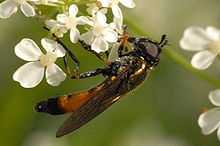Platycheirus granditarsus
From Wikipedia, the free encyclopedia
| Platycheirus granditarsus | |
|---|---|
 | |
| Scientific classification | |
| Kingdom: | Animalia |
| Phylum: | Arthropoda |
| Class: | Insecta |
| Order: | Diptera |
| Family: | Syrphidae |
| Genus: | Platycheirus |
| Subgenus: | Pyrophaena |
| Species: | P. granditarsus |
| Binomial name | |
| Platycheirus granditarsus (Forster, 1771) | |
| Synonyms | |
Platycheirus granditarsus is a species of hoverfly. It is found in many parts of Britain and Europe. Typical habitat includes marshy meadows and ditches, where it can be found between May and October though it is at its commonest between July and September. The most distinctive feature of this fly is the red-orange abdomen most easily seen as it takes off or alights.[1][2][3][4]
References
- ↑ Ball, S.G.; Morris, R.K.A. (2000). Provisional atlas of British hoverflies (Diptera, Syrphidae). Monks Wood, UK: Biological Record Centre. pp. 167 pages. ISBN 1-870393-54-6.
- ↑ Morris, Roger, K. A. (1999). Hoverflies of Surrey. Surrey Wildlife Trust. p. 244. ISBN 0-9526065-3-4.
- ↑ Stubbs, Alan E. and Falk, Steven J. (1983). British Hoverflies: An Illustrated Identification Guide. British Entomological & Natural History Society. p. 253, xvpp.
- ↑ Van Veen, M.P. (2004). Hoverflies of Northwest Europe, Identification Keys to the Syrphidae (Hardback). Utrecht: KNNV Publishing. p. 254. ISBN 90-5011-199-8.
This article is issued from Wikipedia. The text is available under the Creative Commons Attribution/Share Alike; additional terms may apply for the media files.